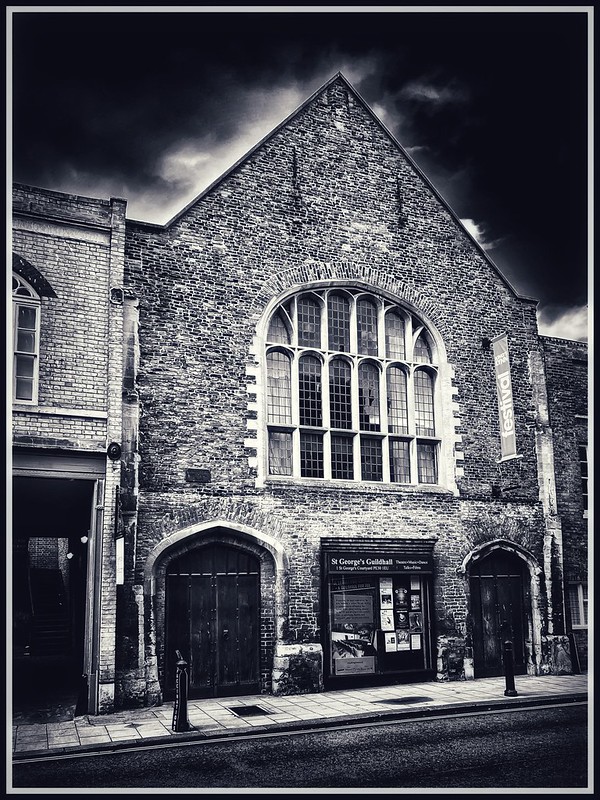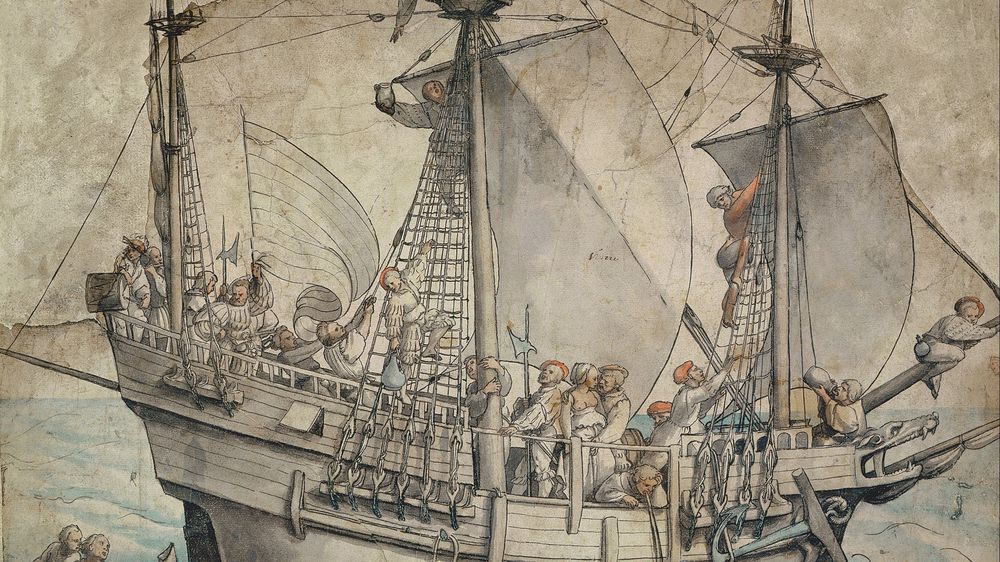Did the King choose a Lynn pirate to accompany his daughter across the North Sea?
I’ve heard it argued that John Brandon (a renowned Lynn merchant) was actually a pirate. But I’m not so sure.
In order to try to answer that question, we need to examine the categories and look at the evidence.
Piracy: The Categories
A pirate is someone who, without authority, captures, or attempts to capture ships at sea. A less formal definition would be a thief who operates on water.
Although ‘pirate’ and ‘piracy’ are often loosely used to refer to many captures of vessels at sea, we need to consider another concept.
Privateering can appear like piracy on the surface, but it is fundamentally different from it. A privateer is someone who has been commissioned by a ruling authority to seize and plunder an enemy’s ships in wartime. If you like, privateering is legitimate piracy. (Privateers were sometimes called corsairs by the French and Spanish.)
The fact that piracy is often confused with privateering is understandable because there isn’t always a clear-cut distinction when operating at sea. There is even more potential for confusion when operating at sea without fast radio communication. The ship’s captain cannot always be sure if the periodic war is still happening, or who precisely the enemy is.
Historically England hasn’t always had a large or strong navy. It was sometimes easier and cheaper to engage privateers to attack your enemies. And some of those privateers may have started out as pirates before having their skills “legitimised”. Alternatively the privateers may be merchants who were seizing an opportunity to make a profit while hoping that authorities at home might not ask too many questions.
John Brandon: The Respectable Citizen

Photo © James Rye 2023
Although not born in the town, by 1372 John Brandon had became a burgess of Lynn. He owned and/or rented land and properties in Great Massingham, Grimston, and Fouldon, as well as properties in what is now Norfolk Street, High Street, and King Street.
in 1406, along with Bartholomew Sistern and John Snailwell, Brandon was granted a charter to re-found the guild dedicated to St George the Martyr.
Brandon was made mayor in 1409 and represented Lynn in four parliaments (1385, 1395, 1397, 1404). In 1425 he secured appointment by the royal council as collector of customs in Lynn. He went on to hold the post there and at Yarmouth for almost 20 years.
It is worth noting that Brandon had good connections. He and John of Gaunt were probably well acquainted, both being co-leasees of a Lynn property in 1383. And Brandon would have welcomed John of Gaunt’s son, King Henry IV, when he visited Lynn in 1406. Henry came to see the departure of his daughter Philipa who was to set sail to marry Eric, King of Norway. Brandon was granted royal letters of protection as second in command (under Nicholas Blackburn, admiral of the north) of the squadron assigned to escort Princess Philippa from Lynn to Helsingborg.
John Brandon: The Traditional Merchant
From the early 1380s John was involved in trading goods. He exported corn and malt to Norway, cloves, wool, and fleeces to Calais, and varieties of cloth, corn, malt, blankets and hides to Netherlands and Prussia. His imports comprised wine, timber, dye-stuffs, soap, pitch and bitumen, and fish. We know that these imported goods were sold by Brandon in Huntingdon, the Midlands and as far afield as Bath.
England at War
During John Brandon’s life England was occasionally at war with at least three main enemies: France, Scotland, and the Hanseatic League. Brandon lived his life in the middle of the Hundred Years War between England and France (1337 -1453), though he probably died in 1414 just before Henry V’s victory at Agincourt in 1415. (The English Kings didn’t officially drop the title of King of France until 1801.) And despite Edward I’s famous “hammering” of the Scots, periodic disputes with Scotland continued in the C14th and C15th.
The third enemy, the Hanseatic League, was not a nation state. It was rather a trading organisation comprising Baltic cities that had joined together in order to get the best commercial terms and to defend themselves. Although the Hanseatic League traded with England (notably in London, Lynn, Boston, and Hull) there were periodic disputes and resentments that sometimes broke out into small-scale wars.
In order to protect English shipping, capture enemy shipping, gather important revenue, and conduct military campaigns, the English rulers at the time would have issued orders to existing ship owners and merchants, authorising them to engage in capture, theft, and destruction for the benefit of the realm. Despite claims that Brandon was a pirate, he, in theory at least, valued the protection of the sea. In july 1410 he was one of the nine Lynn merchants who advanced a loan of 200 marks to the Crown for the safeguarding sea trade. The nation’s rulers, Richard II, Richard’s uncle – John of Gaunt, John of Gaunt’s son – Henry IV, and Henry V, could not rely on a large, efficient, existing navy to do the work.
John Brandon: The Attacks on Shipping

| Privateering? | Piracy? |
|---|---|
| 1385 Brandon and other merchants are commissioned by Parliament to arrest all goods belonging to Prussian (Hanseatic) traders in English ports. This was authorised in retaliation for the seizure of English goods overseas worth £20,000. | |
| 1388 An embassy is sent to Prussia to try to resolve the disputes and Brandon contributes 50s to the cost. | |
| 1394 English ships attacked in Bergen. Lynn merchants (Thomas Hunt, John Brandon, and others) lost goods to the value of £1815. | |
| 1397 Brandon complained that people from Lubeck, Wismar, Rostock, and Stralsund had stolen his goods and had held his agents to ransom. He obtained permission from Richard II to exact reprisals. | 1397 Brandon may have used the permission for reprisals as a pretext for unjustified and indiscriminate acts of plunder. – the seizure in 1397, of money, 11 casks of wine, 13 lasts (units of weight) and four tuns of herring, and 400 tree-trunks, worth in all 318 nobles (£53); the confiscation, in April 1398, of a ship and its freight worth 200 nobles (£33 odd) at Boston; and the theft of goods from a Norwegian ship. |
| In 1404, the magistrates of Stralsund wrote to Henry IV demanding compensation for Brandon’s outrages. | |
| In May 1400 Brandon had been commanded by Henry IV to put to sea with a small fleet of six vessels to fight the Scots. The merchant was so successful that Henry IV paid 500 marks for two of Brandon’s prisoners (Scottish admiral, Sir Robert Logan, and King Robert’s secretary, the archdeacon of Ross); and Brandon no doubt secured additional ransoms for the lesser fry. | In June 1400 Brandon had been ordered by the Henry IV to return a Dieppe barge he had taken at sea. |
| Between 1402 – 1404 the English were responsible for over 55 attacks on Hanseatic Vessels. The German ships were doubly vulnerable if they were suspected of carrying the merchandise of England’s enemies (France and Scotland). Whether or not Brandon was involved, he was certainly regarded as the chief culprit. | |
| In 1403 Brandon captures a Portuguese ship called La Katherine which Henry IV buys off the merchant for £100 for his own use. Brandon later received £46 13s.4d. for repairs carried out on the ship. In addition, in November following he and Roger Galion of Lynn were rewarded with £80 for their labour and expenses in collecting the revenue. | |
| In the spring of 1403 one of his ships, Le Gabriell, had joined in the capture off Brittany of the Seinte Anne of Gironde, laden with wine worth £294, and the Seinte Piere of Spain with her cargo of oil valued at £392. | |
| July 1405, William Glover, the owner of Seinte Anne, seeks a royal review. Brandon has been ordered to return the vessel, but Glover has failed to receive full compensation for his losses. | |
| In April 1406 a royal serjeant-at-arms was commissioned to investigate the 1403 breach of royal letters of protection. |
John Brandon: Was He Or Wasn’t He?
If your ship is being raided and your wealth is being stolen it is clearly irrelevant whether the attacker is a pirate or a privateer. However, the consequences for the attacker, in the long-term, could be important.
Based on the evidence above it could easily be argued that Brandon was both a pirate and a privateer, though certainly before 1404 he seems to have been working more with royal authority (or belated approval) as a privateer. Perhaps, because of the level of activity in the early years of the fifteenth century, Brandon came to sense what he could achieve by using his initiative, and he started to take matters into his own hands.
It may be that we are trying to assess the situation using the wrong criteria. Our twenty-first century categories may be relatively neat and fixed in a way that they weren’t in the late fourteenth and early fifteenth centuries. At sea it wasn’t always easy to know if the country which had been at war was still at war. And if it is difficult to get an answer from a king of government today about the support for an action, it was even more difficult in the Middle Ages. Sometimes, based on past support, it might be worth making an inference and taking a risk. Perhaps the category of privateer was wider and more flexible then than it is today. Certainly the honour bestowed on Brandon by Henry IV in 1406 leaves the impression that the king still regarded this merchant very highly. All medieval kings (with the notable exception of Henry V) benefitted from the actions of pirates. As Nietzsche one wrote: “Merchant and pirate were for a long period one and the same person.” Whichever category Brandon fitted into, he certainly was, as Richards notes, “a champion of English retaliatory action against the German Hanse …”
© James Rye 2024
See also:
Sources
- Eddison, J. (2013) Medieval Pirates: Pirates, Raiders and Privateers 1204 – 1453, The History Press
- History of Parliament Online:
- Richards, P. (2021) Lynn Merchant, Pirate and Guildhall Benefactor: John Brandon, Unpublished paper
- Richards, P. (2022) King’s Lynn and The German Hanse 1250 – 1550, Poppyland Publishing
Book a Walk with a Trained and Qualified King’s Lynn Guide Through Historic Lynn
